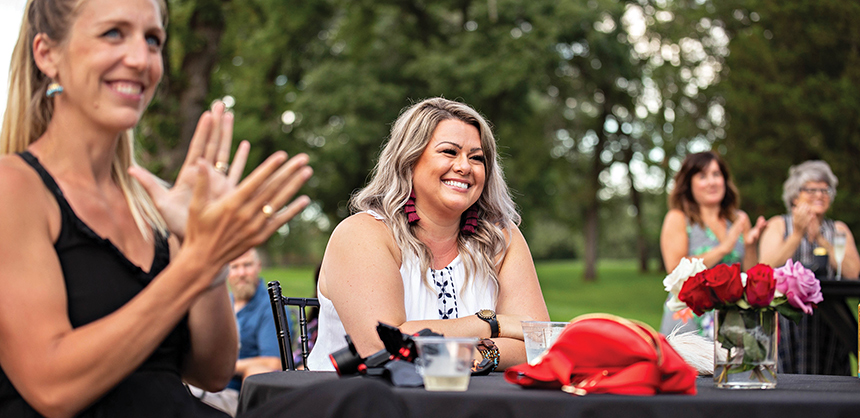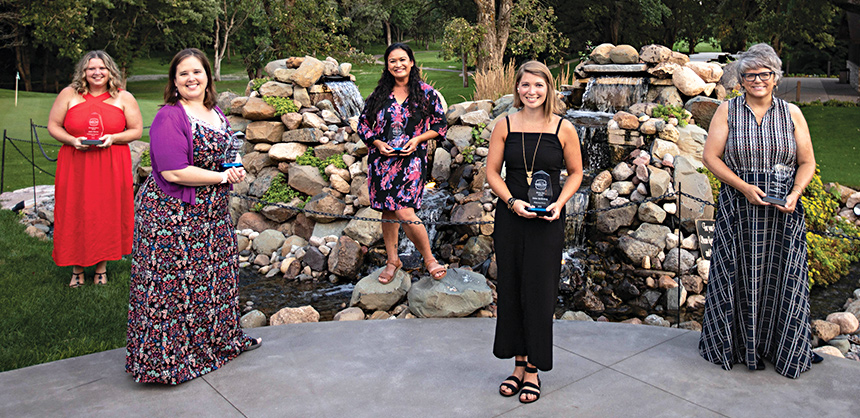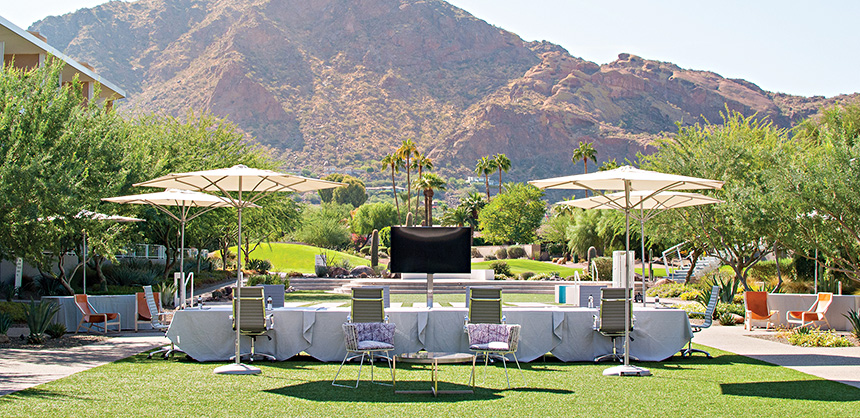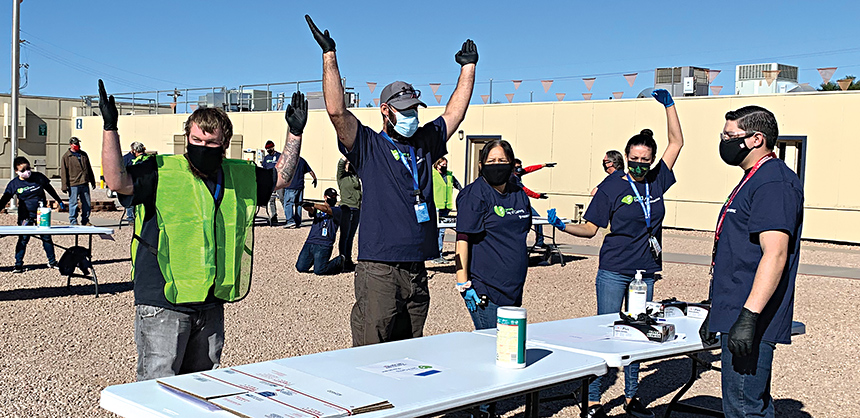How the Pandemic Inspired These Planners to Pivot to Outdoor Meetings and EventsApril 1, 2021
By Keith LoriaHow the Pandemic Inspired These Planners to Pivot to Outdoor Meetings and Events

Outdoor events, held safely, can fill the desire for attendees to meet face to face. Photo Courtesy of Elizabeth Sherry
When COVID-19 started spreading around the country, thousands of meetings and conferences were either cancelled or taken online to a virtual setting. But for some innovative thinkers, these events were simply taken to the outdoors.
For many, the option to be fully virtual or cancel the event entirely is absolutely something that gets considered before going through extra efforts to host an event in person. But after being holed up inside for months, away from co-workers and others, many planners are championing outdoor meetings. After all, people miss networking and seeing each other, and if there is enough support behind having your event be held as safely as possible in person and you can adhere to executive orders and CDC guidelines, then why not try?
Like many planners, David Goldstein, creator of opportunities for Boston-based TeamBonding, pivoted to virtual events once the pandemic hit, but his company has done several outdoor events, which included an ax-throwing event for the U.S. Coast Guard in Massachusetts, a scavenger hunt, a corporate survivor event in Arizona and California, and a few others for corporate events. “Giving people the ability to interact in a social environment while being completely safe has been a challenge that I feel we have met and succeeded,” Goldstein says. “Person-to-person interactions create fun and lasting memories while at the same time working toward a common goal.”
In the early part of this year, TeamBonding worked with Valant, holding an event that was part of Valant’s yearly company conference in Phoenix, Arizona. The event included team members from all over the Southern United States. “We created a custom scavenger hunt that would take them to different parts of the city in teams,” Goldstein says. “There were trivia challenges, team photo challenges as well as team video challenges. They had two hours to complete as many tasks as possible. The COVID pandemic has affected so many people in so many ways that this was an opportunity for them to, if only for a couple of hours, get outside and just enjoy having some fun.”
An obvious tip he would give to anyone planning an outdoor event is to try to anticipate people’s needs, such as hand sanitizer, extra masks, gloves and especially bottled water. “When people see these items, it puts their mind at ease that someone is thinking about their health and safety,” Goldstein says. “Also, make sure you bring an audio system with a microphone. Everyone has a different level of social distancing comfort. In recognizing that, people will be much more spread out than they have been in the past. Having a speaker system will be key to holding a successful event.”

Outdoor events, held safely, can fill the desire for attendees to meet face to face. Photo Courtesy of Elizabeth Sherry
Successful Outings
Elizabeth Sherry, director of special events for Twin Cities Wedding & Event Professionals based in Minnesota, hosted an outdoor award ceremony last summer. She also serves as director of development & strategic partnerships for the Minnesota Chamber Company, and for that job, she helped lead a golf tournament as a corporate outing. “Hosting an outdoor event can have quick logistical challenges if weather does not comply with your plans for the day,” Sherry says. “Fortunately, we were lucky in both my events to not have any rain or severe weather issues. There is a confidence among attendees when you denote an event is going to be outside verses inside during this pandemic.”
Gretchen Bartek, founder and CEO of Adelska, which specializes in planning virtual and in-person events for corporate and nonprofit groups, says she has hosted numerous outdoor gatherings for groups since the pandemic. The most recent was an outdoor picnic with a livestreamed concert for a tech company. “We have to be really conscious that everyone has a different level of comfort, so all food was packaged separately, while still in a really beautiful presentation in a personalized, vintage lunchbox,” Bartek says. “Inside were their preferred drinks on ice, so they never had to go to the bar unless they wanted to. Throughout the night, we had different food items spread out across the venue from charcuterie to picnic baskets, to cake jars. We had personal picnic blankets set up with pillows, throws if they got cold and candles with a perfect view of the 15-foot screen so they could enjoy a private song set from JJ Grey.”
Todd Zimmerman, president elect of the International Live Events Association’s (ILEA) Orlando, Florida Chapter, notes the organization has been sponsoring in-person member meetings since last June, and has learned how to effectively keep attendees safe while continuing to gather during the pandemic. “As part of our commitment to our members, we produce member-centered events monthly,” he says. “Since the pandemic, we have had to adjust these member events considerably. Some of that has been virtual, but we are lucky that we are based in Florida, which affords us year-round outdoor availability to hold events.”
ILEA Orlando kicked off the return of outdoor events with its June meeting and held it at a local theater that had painted a large screen on the outside of their building to set it up for a drive-in movie experience. “Participants were able to drive their cars in and park in every other space for safe distancing,” Zimmerman says. “We had a food truck, DJ, photo booth and caricature artist set up in the parking lot to provide music, food and activities for the guests as they arrived. We required mask wearing outside of their vehicles.”
The organizers filmed a short video for the participants to watch to get them in the mood for a movie evening, and then held an award presentation before showing a feature movie on the big screen. “People were clamoring to get out and socialize again, and everyone was able to do that safely and enjoy themselves,” Zimmerman says.
Its second successful event was a wellness and yoga night held on a rooftop of a downtown office building. A local juicing company provided refreshments on eco-responsible disposable dinnerware, and a wellness company led members through a meditation session and then some group yoga.

Planners suggest having several back-up plans in the event of bad weather. Moving indoors may not be an option during the pandemic. Photo Courtesy of Jesse Thompson
Mountain Shadows Resort Scottsdale in Paradise Valley, Arizona, not only offers spacious grounds for hosting outdoor events, but also flexible indoor/outdoor space that opens to views of the golf course and desert surroundings. That has made holding outdoor meetings and events a great opportunity. “The ability to have a meeting without interruptions, noise impediments and/or temperature/exposure issues is what makes it successful,” says Jesse Thompson, area director for the resort. “What makes it special is the view, or the simple fact that your surroundings are so different than a meeting or boardroom. The venue should offer power, shade, quiet enjoyment and the ability to have nature surround you.”
The resort recently held an outdoor, boardroom-style meeting for a group. “They wanted innovation and the ability to basically pick up an indoor environment and move it outdoors, so we did,” Thompson says. “While the actual boardroom table was re-created through banquet tables, we used the boardroom executive chairs and spaced them 6 feet apart for the attendees, placed a 65-inch television on a rolling mount for their presentation needs, and of course, provided sunscreen and umbrellas.”
Ben Rotundo, lead facilitator of a TeamBonding franchise in Las Vegas, worked on a Military Care event in November, and Pacific Scientific Energetic Materials Company worked with him to do whatever was needed from a COVID protocol perspective to make it a safe event. “The success was the forethought of the client and event manager about facilities and supplies, the willingness of our facilitator team to adapt the program and set up as needed once we saw the outdoor space and their COVID-plan for social distancing,” he says. “We brainstormed a bunch about ‘back pocket’ activities just so we could be ready for anything. The company did a fabulous job of working in tandem with us.”
For this event, they were forced to tweak the program to minimize the amount of touching similar items, and they cut out a few activities and added others that they could do in their socially distant, six-person teams. “As a team-building provider of more than 100 in-person events, we always knew that one size doesn’t fit all, and that events themselves have always and will always evolve,” Rotundo says. “With the pandemic, we have had to and will have to be versatile and be ready to change as their needs and the regulations changed. One of the things that will never change is our concern for the safety and health of our team.”

Outdoor events are an excellent way to create team building activities and other activities that build stronger bonds between co-workers. Photo Courtesy of David Goldstein
Challenges Abound
Obviously, one of the biggest challenges of planning an outdoor meeting during this time is making the client and all participants feel safe. “Everyone has a different spectrum of their comfort level,” Goldstein says. “Trying to anticipate and meet those needs can be a challenge.”
You can never guarantee good weather, so anyone hosting any sort of corporate gathering outside must have a contingency plan. For example, last October, the Minnesota Chamber was planning an outdoor monthly networking event in a tent,” Sherry says. “The second week in October could be 70 degrees and perfect, or could sometimes be residents’ first taste of a winter to come. Well, sadly, ours was the latter. ”
Many types of events require supplies, paperwork, props, etc., so while snow and rain are big problems, wind also can be quite the challenge. Zimmerman adds that, in non-COVID times, it’s easy to set a rain contingency indoors, providing the outdoor venue has an attached indoor space. However, in the pandemic, that planning was more difficult under social distancing requirements.
Another challenge is that people tend to remove masks more quickly outdoors and move in closer to be able to hear. “Creating a healthy environment is more of a challenge because of this, so as a planner, we need to look for spaces with lower noise levels that can foster easier communication and have reminders to the guests about distancing and mask protocols to keep everyone safe,” Zimmerman says.
In his opinion, a planner should have three plans for any outdoor event — the one you want, the contingency you need, and the “Sasquatch plan” for when something totally unexpected comes lumbering out of the bushes and you need to address it. “And find areas that can be exclusive to your group so that you don’t have to worry about uninvited participants crashing your event,” he says.
Bartek notes the most challenging part is ensuring everyone’s comfort level is met, and her company thinks hard about how to make that happen. “It’s a personal choice, and we want to make sure every single attendee knows we thought about them personally so they can just enjoy the social time we’ve all been craving so much,” she says. “We’re in Colorado and it’s cold right now. We have an event coming up that’s 100% outside. We’re going to send them skating on a frozen lake in the foothills. We’ll be providing a personal thermos with drinks and soup, custom flasks, blankets and rechargeable hand warmers. And for those that are comfortable with it, we’ll have warming huts.”
Another item to be cognizant of is the A/V equipment, if required. “In an outdoor setting, you need a television or LCD projector with much more brightness or additional lumens than you need indoors, to be seen,” Thompson says. “These items, if rented, can be a bit more costly than your traditional indoor equipment.”
Lessons Learned
With a small sample of outdoor events now behind her, Sherry notes some lessons learned could easily be related to setting internal expectations appropriately. “Expect a lower guest count then you thought prior and don’t be disappointed by it,” she says. “The consumer confidence is not back yet in full steam, or even half steam. Prepare budgets and internal expectations accordingly for this.” She also suggests for those considering holding their first-ever outdoor meeting to start with a small group, see how it goes, learn from it, and then think about what your audience needs next within what you are allowed to do.
The biggest lesson Zimmerman has learned with planning outdoor events is that clear communication is key to creating a successful event, “letting the participants know that we are committed to safety in an outdoor setting just as much as we would for something indoors,” he says. “This helps inspire responsibility with the participants as well and makes for a pleasant experience.” Also important is knowing the comfortability of the participants to gather.
Bartek thinks it’s really important to continually think about every touch point from all levels of comfort. Questions to ponder include: Are groups going to congregate in one area? How can you get them to spread out naturally? Do you have all of the items needed on hand to make everyone comfortable? “We found that keeping it small was actually more fun,” she says. “It gives this unique opportunity to trigger an emotional reaction with guests as we have the opportunity to get so much more personal with smaller groups.”
“Expect a lower guest count then you thought prior and don’t be disappointed by it.” — Elizabeth Sherry, Director of Special Events, Twin Cities Wedding, & Event Professionals
Based on what he experienced, Thompson now recommends conducting more brief meetings outdoors and using it as only a portion of the day’s events. “For example, we had a large group — 50 people is large in COVID-19 times — and they did a socially distanced theater setup on the lawn for all 50 attendees,” he explains. “This was used as the opening session of the conference with ice breaker material that lasted only about 60-90 minutes, and then they broke out to indoor space for other meetings.”
An important lesson Goldstein learned from early attempts at outdoor events is that everyone’s personal comfort level is very different. More so now than ever before. “Due to the COVID pandemic and how it has affected people on a personal level, their individual feelings of social distancing and sanitation can be extremely different, and it was very important for everyone to feel safe, so much so that with a 200-person event, we had teams spread out as far as a football field. That then lends itself to other challenges. You try to plan for every situation, but a willingness to be open to momentary changes and restructuring is key.”
The New Normal?
With vaccines rolling out and companies projecting that things will be getting somewhat back to normal by this fall, many are wondering if people will still want to get together inside for big meetings and conventions anytime soon. That’s why many expect the outdoor meetings to continue late into this year and beyond. “From what I saw in 2020 when the weather was nice in Minnesota, folks regained a love for the outdoors, personally and professionally,” Sherry says. “How many co-workers do you know that took their Zoom call outside because it was nice? I think outdoor events will be a preferred way to meet if the weather is nice regardless of the possible logistical challenges.”
Bartek notes her company will continue outdoor events for corporate events, especially as the Colorado weather gets warmer. “Being social is human nature, and people will always crave that face-to-face contact for personal connections,” she says.
There is no substitute for human interaction. Being face-to-face with someone is critical in many aspects of life. From a handshake, wave, or even fist bump, it’s a social sign of respect. “Zoom, Google Meets, etc., have been an invaluable tool to help the world continue to communicate. The world has been forced to change and those tools have helped us do that,” Goldstein says. “But the one thing they lack is the human component. And yet with all this technology, the most enjoyable way to celebrate something is in person. Team building is a celebration, and we will continue to celebrate together.” C&IT








